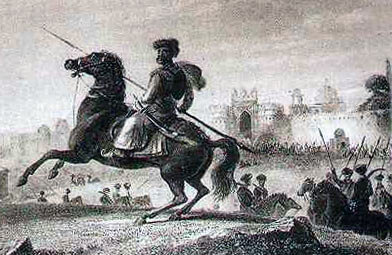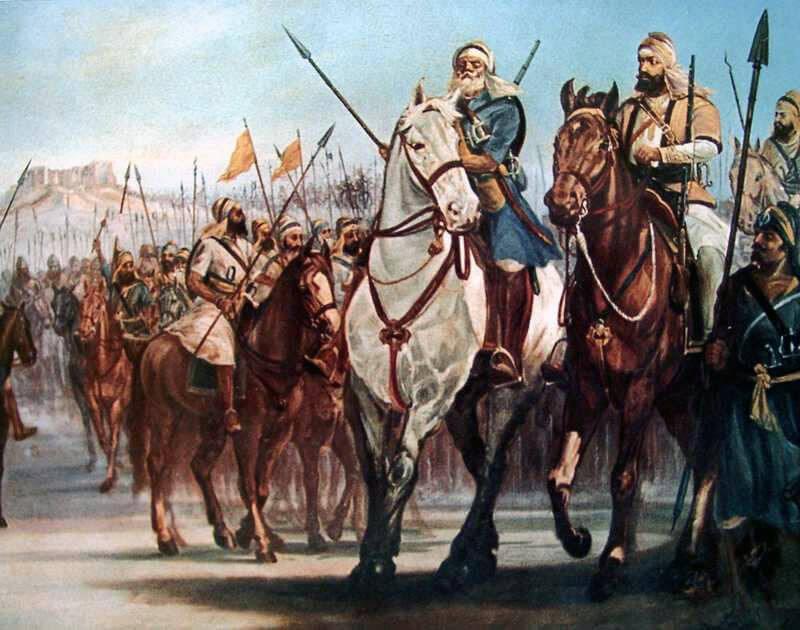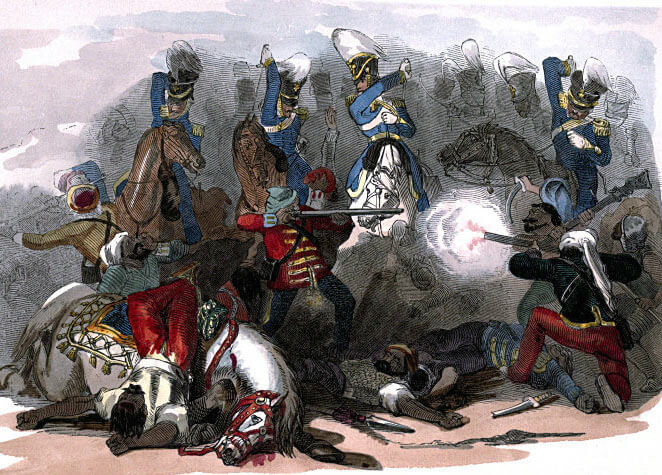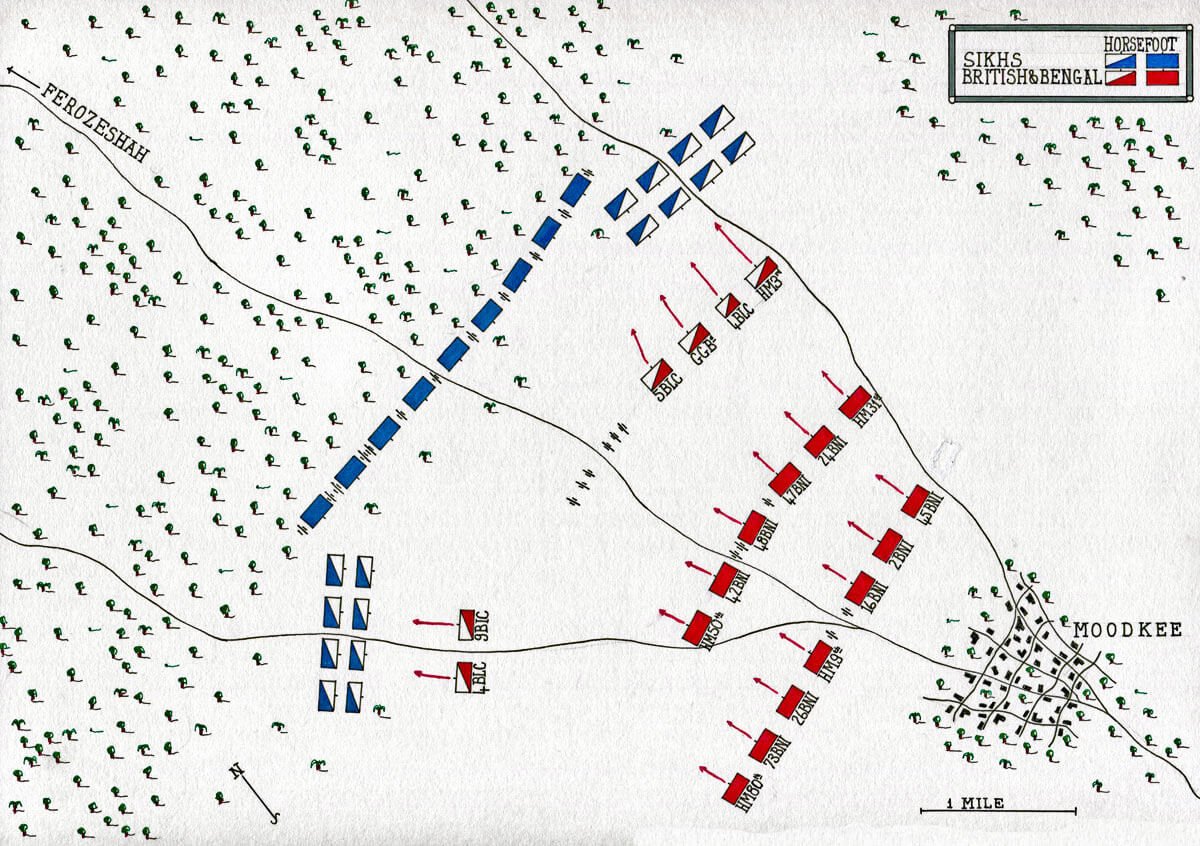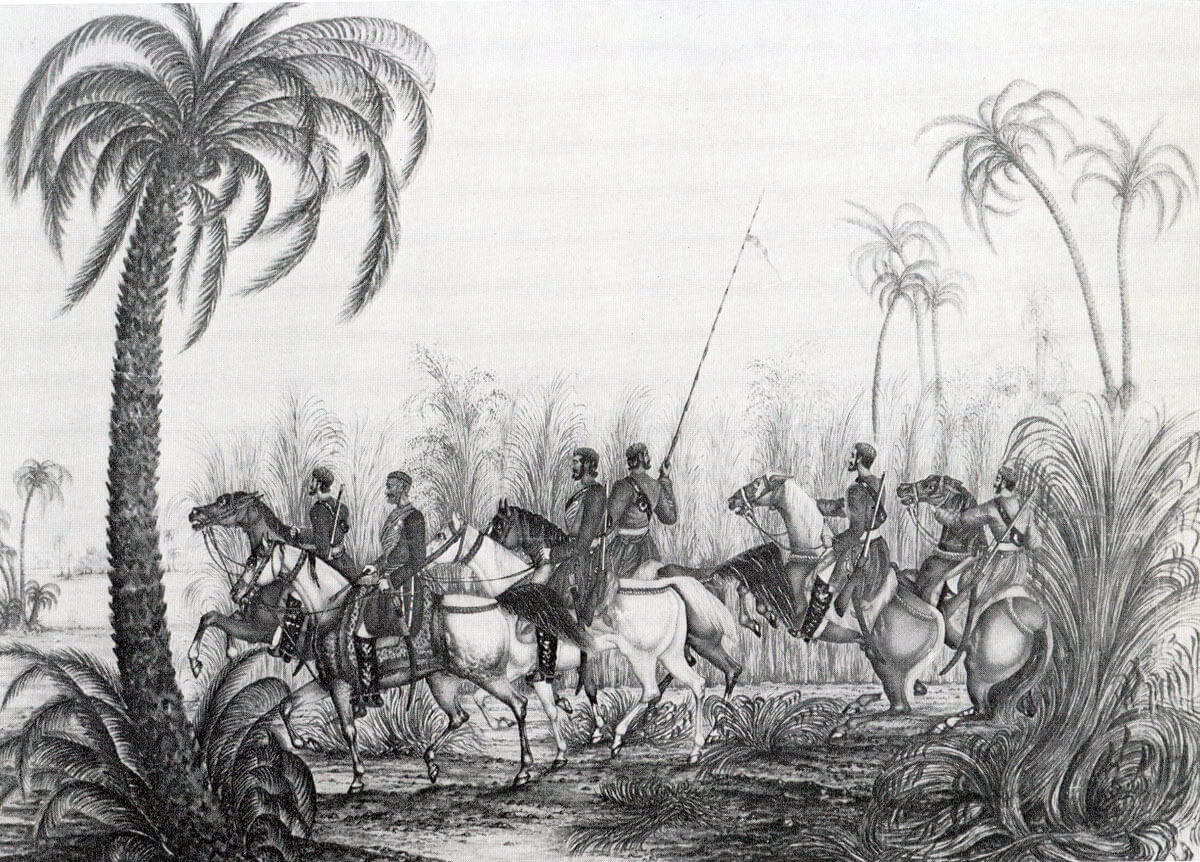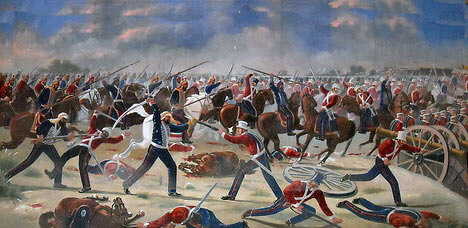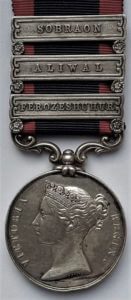General Gough’s hard won victory over the Sikh army
of Lal Singh on 18th December 1845; the opening battle of the First Sikh War
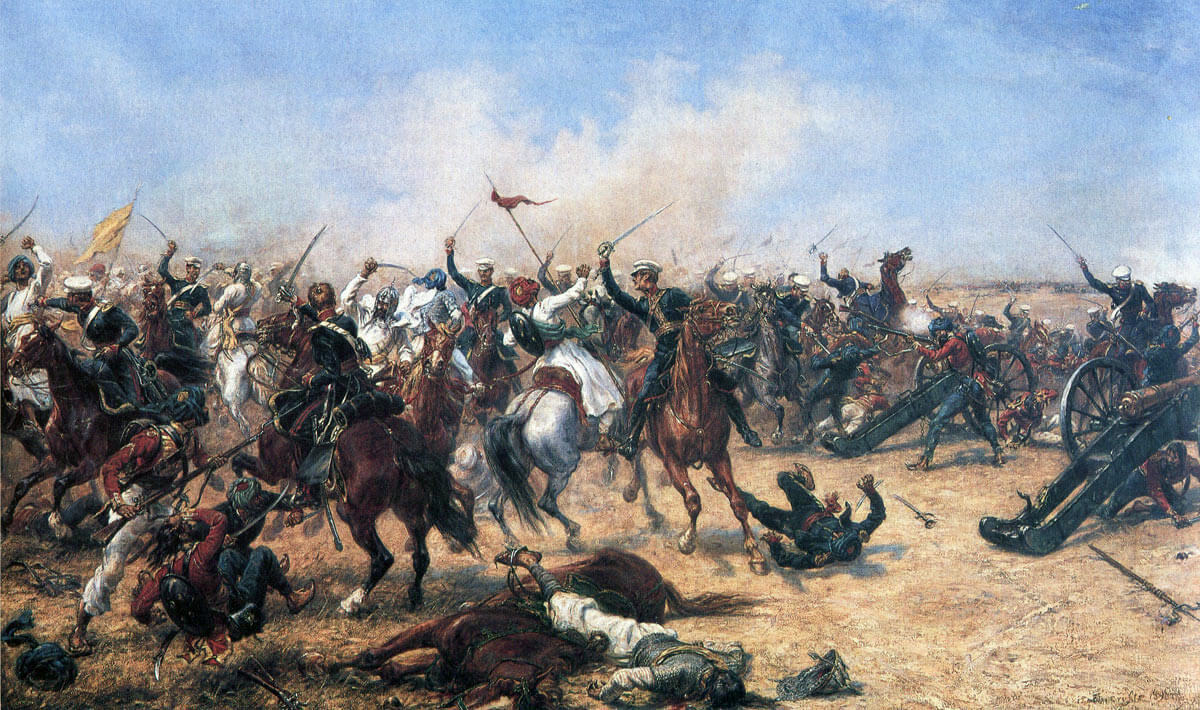
Charge of the 3rd King’s Own Light Dragoons at the Battle of Moodkee on 18th December 1845 during the First Sikh War: picture by Ernest Crofts
The previous battle in the British Battle sequence is the Battle of Kabul 1842
The next battle in the First Sikh War is the Battle of Ferozeshah
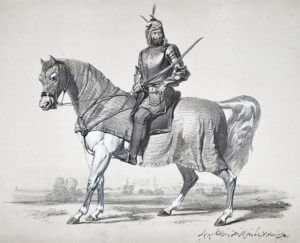
Raja Lal Singh, Sikh commander at the Battle of Moodkee on 18th December 1845 during the First Sikh War: picture by Henry Martens
Battle: Moodkee
War: First Sikh War.
Date of the Battle of Moodkee: 18th December 1845.
Place of the Battle of Moodkee: On the south bank of the Sutlej River in the Punjab in North West India.
Combatants at the Battle of Moodkee: British troops and Indian troops of the Bengal Presidency against Sikhs of the Khalsa, the army of the Punjab.
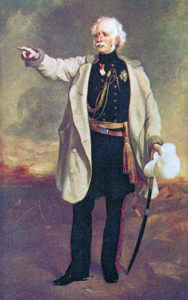
Major General Sir Hugh Gough in his white ‘Battle Coat’: Battle of Moodkee on 18th December 1845 during the First Sikh War
Commanders at the Battle of Moodkee: Major General Sir Hugh Gough and General Sir Henry Hardinge, the Governor General of Bengal, against Lal Singh, the Sikh leader.
Size of the armies at the Battle of Moodkee: A British and Bengal army of 12,000 troops and 42 guns against a Sikh army of 10,000 cavalry, 4,000 infantry and 22 guns.
Uniforms, arms and equipment at the Battle of Moodkee (this section is the same in each of the battles of the Sikh Wars):
The two wars fought between 1845 and 1849 between the British and the Sikhs led to the annexation of the Punjab by the British East India Company, and one of the most successful military co-operations between two races, stretching into a century of strife on the North West Frontier of British India, the Indian Mutiny, Egypt and finally the First and Second World Wars.
The British contingent comprised four light cavalry regiments (3rd, 9th, 14th and 16th Light Dragoons- the 9th and 16th being lancers) and twelve regiments of foot (9th, 10th, 24th, 29th, 31st, 32nd, 50th, 53rd, 60th, 61st, 62nd and 80th regiments).
The bulk of General Gough’s ‘Army of the Sutlej’ in the First Sikh War and ‘Army of the Punjab’ in the Second Sikh War comprised regiments from the Bengal Presidency’s army: 9 regular cavalry regiments (the Governor-General’s Bodyguard and 1st, 3rd, 4th, 5th, 6th, 7th, 8th and 11th Bengal Light Cavalry), 13 regiments of irregular cavalry (2nd, 3rd, 4th, 7th to 9th and 11th to the 17th Bengal Irregular Cavalry), 48 regiments of foot (1st to 4th, 7th, 8th, 12th to 16th, 18th, 20th, 22nd, 24th to 27th, 29th to 33rd, 36th, 37th, 41st to 54th, 56th, 59th, 63rd and 68th to 73rd Bengal Native Infantry), horse artillery, field artillery, heavy artillery and sappers and miners.
The Bombay presidency contributed a force that marched in from Scinde, in the west, and gave considerable assistance at the Siege of Multan; the 19th Bombay Native Infantry gaining the title of the Multan Regiment for its services in the siege, a label still held by its Indian Army successor.
A Bombay brigade under Brigadier Dundas joined General Gough’s army for the final battle of the Second Sikh War at Goojerat, where the two regiments of Scinde Horse, Bombay Irregular Cavalry, particularly distinguished themselves. The brigade comprised: 2 regiments of Scinde Horse, 3rd and 19th Bombay Native Infantry and Bombay horse artillery and field artillery.
Each of the three presidencies, in addition to their native regiments, possessed European infantry, of which the 1st Bengal (European) Infantry, 2nd Bengal (European) Light Infantry and 1st Bombay (European) Fusiliers took part in the Sikh Wars.
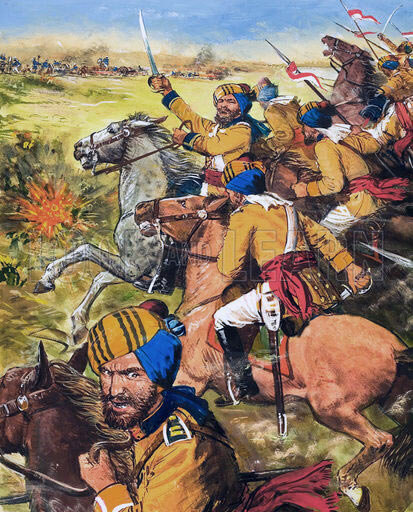
Skinner’s Horse at the Battle of Moodkee on 18th December 1845 during the First Sikh War: picture by Cecil Doughty
Other corps fought under the British flag, such as the Shekawati cavalry and infantry and the first two Gurkha regiments: the Nasiri Battalion (later 1st Gurkhas) and the Sirmoor Battalion (later 2nd Gurkhas).
General Gough commanded the British/Indian army at 6 of the 7 major battles (not the Battle of Aliwal). An Irishman, Gough was immensely popular with his soldiers, for whose welfare he was constantly solicitous. The troops admired Gough’s bravery, in action wearing a conspicuous white coat, which he called his ‘Battle Coat’, so that he might draw fire away from his soldiers.
Gough’s tactics were heavily criticised, even in the Indian press in letters written by his own officers. At the Battles of Moodkee, Sobraon and Chillianwallah, Gough launched headlong attacks, considered to be ill-thought out by many of his contemporaries. Casualties were high and excited concern in Britain and India. By contrast, Gough’s final battle, Goojerat, which decisively won the war, cost few of his soldiers their lives and was considered a model of care and planning.
Every battle saw vigorous cavalry actions, with HM 3rd King’s Own Light Dragoons and HM 16th Queen’s Royal Lancers particularly distinguishing themselves. The British light cavalry wore embroidered dark blue jackets and dark blue overall trousers, except the 16th who bore the sobriquet ‘the Scarlet Lancers’ for their red jackets. The headgear of the two regiments of light dragoons was a shako with a white cover; the headgear of the lancers the traditional Polish tschapka.
HM regiments of foot wore red coats and blue trousers with shakos and white covers.
The Bengal and Bombay light cavalry regiments wore pale blue uniforms. The infantry of the presidency armies wore red coats and peak less black shakos.
The weapons for the cavalry were the lance for the lancer regiments and sword and carbine for all; the infantry was armed with the Brown Bess musket and bayonet.
Commands in the field were given by the cavalry trumpet and the infantry drum and bugle.
In the initial battles, the Sikh artillery outgunned Gough’s batteries. Even in these battles and in the later ones, the Bengal and Bombay horse and field artillery were handled with great resource and were a major cause of Gough’s success.
Many of the more senior British officers had cut their military teeth in the Peninsular War, and at the Battle of Waterloo: Gough, Hardinge, Havelock of the 14th Light Dragoons, Cureton, Dick, Thackwell and others. Many of the younger men would go on to fight in the Crimea and the Indian Mutiny.
The Sikhs of the Punjab looked to the sequence of Gurus for their spiritual inspiration, and had established their independence, fiercely resisting the Moghul Kings in Delhi and the Muslims of Afghanistan. The Sikhs were required by their religion to wear the ‘five Ks’, not to cut their hair or beard and to wear the highly characteristic turban, a length of cloth in which the hair is wrapped around the head.
The Maharajah of the Punjab, Ranjit Singh, whose death in 1839 ended the Sikh embargo on war with the British, established and built up the powerful Sikh Army, the ‘Khalsa’, over the twenty years of his reign. The core of the ‘Khalsa’ was its body of infantry regiments, equipped and trained as European troops, wearing red jackets and blue trousers. The Sikh artillery was held in high esteem by both sides. The weakness in the Sikh army was its horse. The regular cavalry regiments never reached a standard comparable to the Sikh foot, while the main element of the mounted arm comprised clouds of irregular and ill-disciplined ‘Gorcharras’.
The traditional weapon of the Sikh warrior is the ‘Kirpan’, a curved sword kept razor sharp and one of the ‘five Ks’ a baptised Sikh must wear. In battle, at the first opportunity, many of the Sikh foot abandoned their muskets and, joining their mounted comrades, engaged in hand to hand combat with sword and shield. Horrific cutting wounds, severing limbs and heads, were a feature of the Sikh Wars, in which neither side gave quarter to the enemy.
It had taken the towering personality of Ranjit Singh to control the turbulent ‘Khalsa’, he had established. Ranjit Singh’s descendants found the task beyond them and did much to provoke the outbreak of the First Sikh War, in the hope that the Khalsa would be cut down to size by the armies of the British East India Company. The commanders of the Sikh armies in the field rarely took the initiative in battle, preferring to occupy a fortified position and wait for the British and Bengalis to attack. In the opening stages of the war there was correspondence between Lal Singh and the British officer, Major Nicholson, suggesting that the Sikhs were being betrayed by their commander.
Pay in the Khalsa was good, twice the rate for sepoys in the Bengal Army, but it was haphazard, particularly after the death of Ranjit Singh. Khalsa administration was conducted by clerks writing in the Persian language. In one notorious mutiny over pay, Sikh soldiers ran riot looking for anyone who could, or looked as if they could, speak Persian, and putting them to the sword.
The seven battles of the war and the siege of the city of Multan were hard fought. Several of the battle fields were wide flat spaces broken by jungly scrub, from which the movement of large bodies of troops in scorching heat raised choking clouds of dust. As the fighting began, the dust clouds intermingled with dense volumes of musket and cannon smoke. With the thunder of gunfire and horses’ hooves, the battle yells and cries of the injured, the battles of the Sikh Wars were indeed infernos.
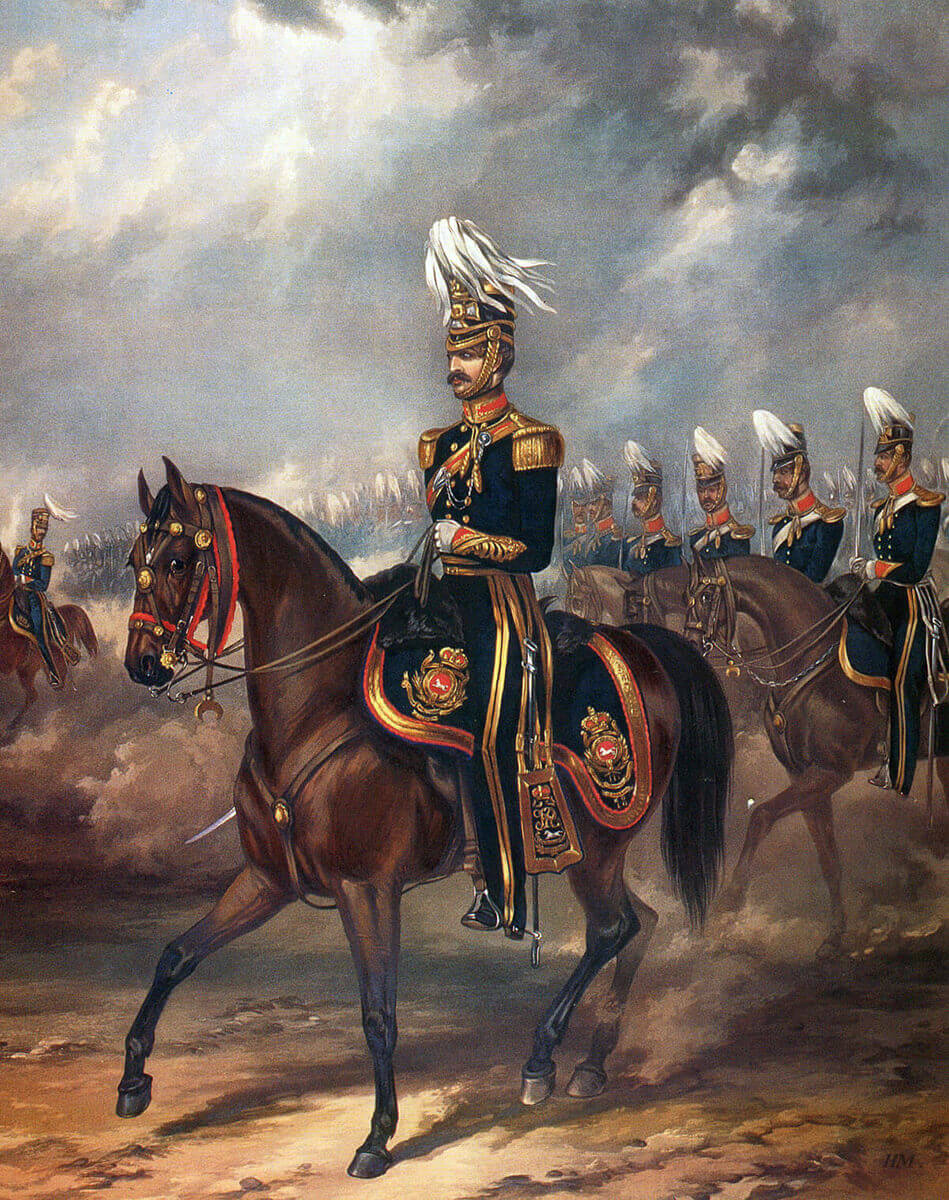
3rd King’s Own Light Dragoons: Battle of Moodkee on 18th December 1845 during the First Sikh War: picture by Ackermann
Winner of the Battle of Moodkee: The British and Bengali troops of General Gough’s ‘Army of the Sutlej’.
British and Indian Regiments at the Battle of Moodkee:
British:
HM 3rd King’s Own Light Dragoons: now the Queen’s Royal Hussars.*
HM 9th Foot, later the Norfolk Regiment and now the Royal Anglian Regiment.*
HM 31st Foot, later the East Surrey Regiment and now the Princess of Wales’s Royal Regiment.*
HM 50th Foot, later the Queen’s Own Royal West Kent Regiment and now the Princess of Wales’s Royal Regiment.*
HM 80th Foot, later the South Staffordshire Regiment and now the Staffordshire Regiment.*
Indian:
The Governor General’s Bodyguard.*
4th Bengal Light Cavalry.*
5th Bengal Light Cavalry.*
Skinner’s Horse.*
8th Irregular Horse.*
9th Irregular Horse.*
2nd Bengal Native Infantry.*
16th Bengal Native Infantry.*
24th Bengal Native Infantry.*
26th Bengal Native Infantry.*
42nd Bengal Native Infantry.*
45th Bengal Native Infantry.*
47th Bengal Native Infantry.*
48th Bengal Native Infantry.*
73rd Bengal Native Infantry.*
Horse and Field Artillery.
The Indian Army regiments:
Cavalry:
The Governor General’s Bodyguard continues as the President of India’s Bodyguard.*
Skinner’s Horse in 1861 became the 1st Bengal Cavalry, in 1903 the 1st Duke of York’s Own Lancers (Skinner’s Horse), in 1922 the 1st Duke of York’s Own Skinner’s Horse and from 1950 the 1st Horse of the Indian Army.*
8th Bengal Irregular Cavalry in 1861 became the 6th Bengal Cavalry, in 1906 the 6th King Edward’s Own Cavalry, in 1922 the 18th King Edward’s Own Cavalry and from 1950 the 18th Cavalry of the Indian Army.*
All the regular Bengal cavalry regiments that fought at Moodkee and the 9th Irregular Horse ceased to exist in 1857 to 1861.
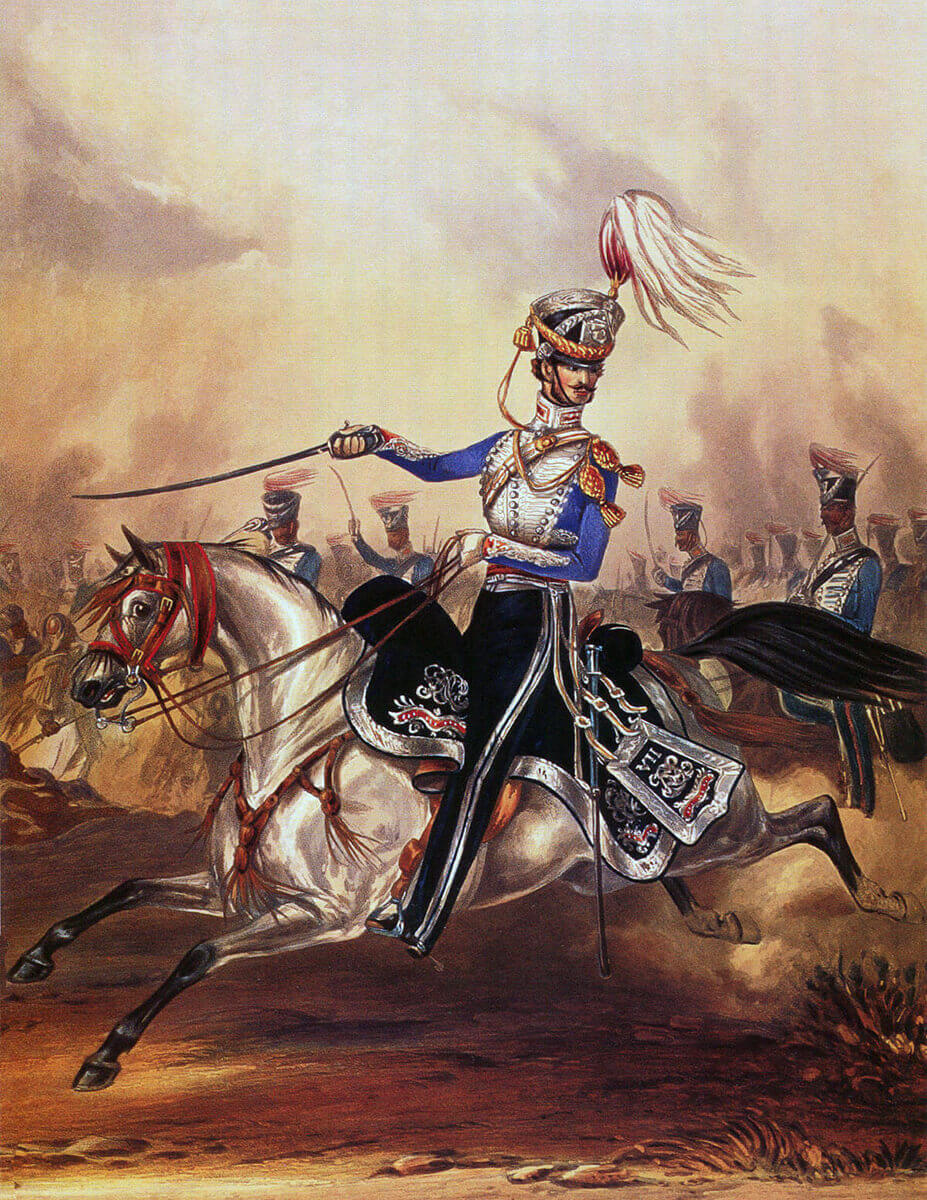
Bengal Light Cavalry: Battle of Moodkee on 18th December 1845 during the First Sikh War: picture by Ackermann
Infantry:
42nd Bengal Native Infantry in 1861 became the 5th Light Infantry and were disbanded in 1922.*
47th Bengal Native Infantry in1861 became the 7th Bengal Light Infantry, in 1903 the 7th Duke of Connaught’s Own Rajputs, in 1922 the 3rd Battalion (Duke of Connaught’s Own), 7th Rajput Regiment and from 1950, the 3rd Battalion, the Rajput Regiment of the Indian Army.*
The remaining Bengal infantry regiments that fought at Moodkee ceased to exist in 1857.
* These regiments have or had Moodkee as a battle honour.
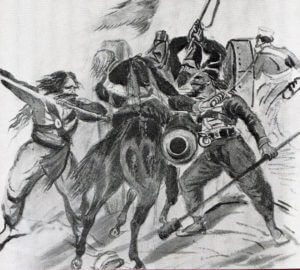
Captain Codd of 3rd King’s Own Light Dragoons cut to pieces by Sikhs at the Battle of Moodkee on 18th December 1845 during the First Sikh War
The order of battle of the Army of the Sutlej at the Battle of Moodkee:
Commanding in Chief: Major General Sir Hugh Gough.
Second in Command: Major General Sir Henry Hardinge, Governor General of Bengal.
Cavalry Division: Major General Sir Joseph Thackwell.
Brigadier Mactier’s brigade: 9th Bengal Irregular Horse and one wing of 4th Bengal Light Cavalry.
Brigadier Gough’s brigade: 5th Bengal Light Cavalry and the Governor General’s Bodyguard.
Brigadier White’s brigade: HM 3rd King’s Own Light Dragoons and one wing of 4th Bengal Light Cavalry.
1st Infantry Division: Major General Sir Harry Smith.
1st Brigade: Brigadier Bolton; HM 31st Foot, 24th and 47th BNI.
2nd Brigade: Colonel Wheeler; HM 50th Foot, 42nd and 48th BNI.
2nd Infantry Division: Major General Gilbert.
1st Brigade: 2nd and 45th BNI.
2nd Brigade: 16th BNI.
3rd Infantry Division: Major General McCaskill.
1st Brigade: HM 9th Foot, 26th and 73rd BNI.
2nd Brigade: –
Artillery:
5 troops of horse artillery and 2 batteries of light field artillery.
Account of the Battle of Moodkee:
On 11th December 1845, a Sikh army crossed the Sutlej River to attack the British garrisons in the southern Punjab towns of Ferozepore, Ludhiana and Ambala. The First Sikh War had begun.
Until the death of the great Sikh ruler of the Punjab, Ranjit Singh, relations between the Sikhs and the British East India Company had been harmonious. Ranjit Singh co-operated with the British during the First Afghan War and the Sind War. But Ranjit Singh’s death in 1839 triggered acrimonious disputes within his family, and with the powerful Khalsa, an institution motivated by aggressive antipathy to the British.
Ranjit Singh, during his long rule, turned the Khalsa into an efficient and powerful fighting force, but one that required an iron hand to keep it in check. While Ranjit Singh had been such an iron hand, his successors were not. In the war that broke out in 1845, the British were fortunate that the rulers of the Punjab did all they could to betray their army, as it fought the British. It may well be that the Khalsa was encouraged to begin the war, in the hope that it would be severely beaten and rendered less of a threat to its own rulers.
Even though the British had for some time expected exactly such an eruption by the Sikh army across the Sutlej, one of the five great rivers of the Punjab, inadequate preparations had been made.
The British authorities were reluctant to expose the Bengal sepoy army to Sikh propaganda, which claimed that soldiers joining their army could expect a doubling of their pay. It was feared that any success on the part of the Sikhs would cause sepoys to desert.
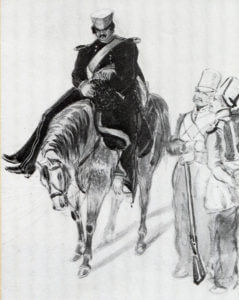
Trooper of 3rd King’s Own Light Dragoons bringing in the headless body of his brother after the Battle of Moodkee on 18th December 1845 during the First Sikh War
The Sikh force of 50,000 men and 200 guns, commanded by Tej Singh, moved towards Ferozepore, held by a British garrison of some 7,000 troops, but did not attack it.
The British commander-in-chief, Sir Hugh Gough, accompanied by the Governor General, Sir John Hardinge, assembled troops from Ambala and Ludhiana, and moved forward to relieve the garrison at Ferozepore and attack the Sikhs. The force took the name of the ‘Army of the Sutlej.’
On 18th December 1845, after a long day’s march, the Army of the Sutlej approached the small town of Moodkee. A reconnaissance, commanded by Major George Broadfoot, discovered a body of Sikhs, probably around 2,000 infantry, 10,000 cavalry and 22 guns, in occupation of the town.
By the time the Army of the Sutlej came up, the Sikhs had withdrawn to a position behind the town on the edge of the jungle.
Fearing that the Sikhs might retreat into the jungle at their back, Gough ordered an immediate attack, and his army, despite its state of exhaustion, marched out of the town.
As night fell, the five troops of horse artillery galloped into action, soon joined by the two batteries of field artillery. The Bengal guns opened a bombardment, firing into the jungle fringe, where the Sikh force was positioned.
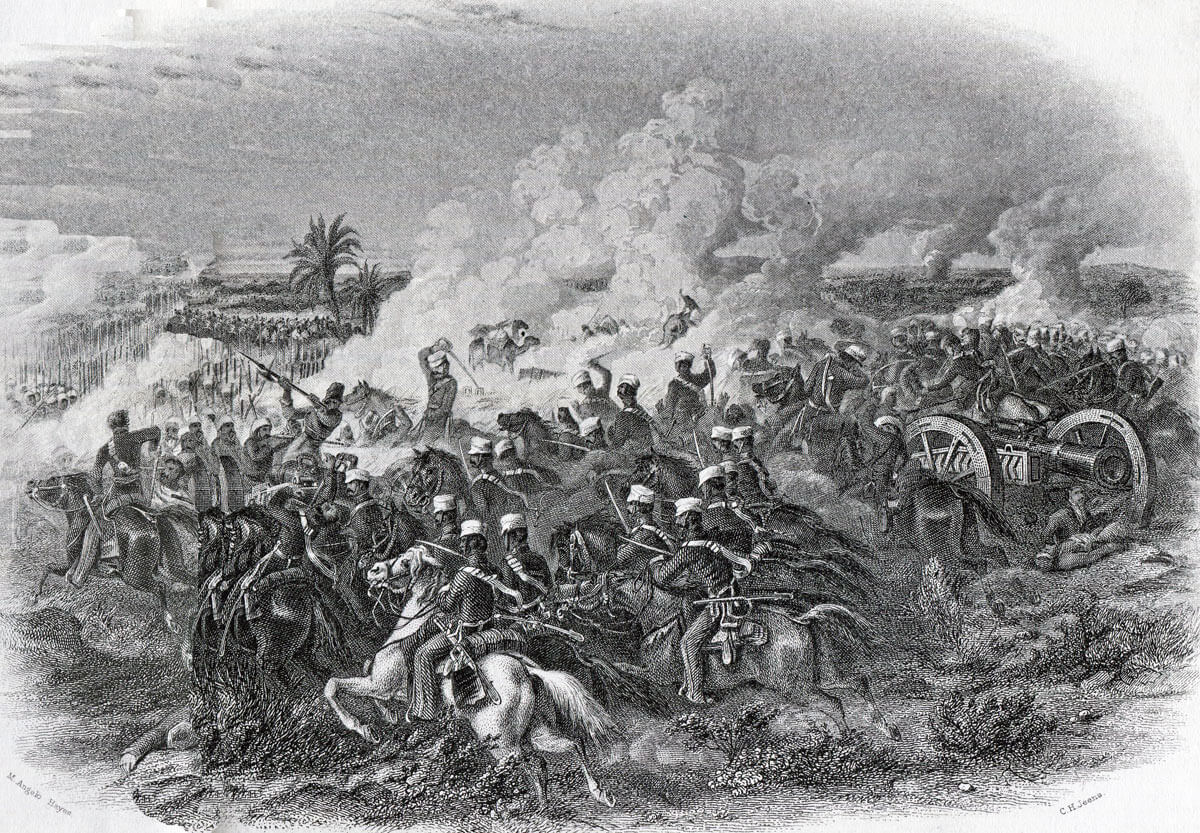
The Charge of the ‘Devil’s Children’: 3rd King’s Light Dragoons at the Battle of Moodkee on 18th December 1845 during the First Sikh War
Meanwhile Gough ordered his cavalry brigades to attack around each of the Sikh flanks; on the right the brigade commanded by Brigadiers White and Gough, comprising HM 3rd Light Dragoons, a wing of the 4th Bengal Light Cavalry, the Governor General’s Bodyguard and the 5th Bengal Light Cavalry; on the left the brigade under Brigadier Mactier, comprising the other wing of the 4th Bengal Light Cavalry and the 9th Bengal Light Cavalry.
In the twilight caused by darkness and the clouds of dust churned up by the horses’ hooves, the 3rd Light Dragoons and the Governor General’s Bodyguard charged into the Sikh line on the edge of the jungle, turning the Sikh flank.
On the left flank, the 4th and 9th Bengal Light Cavalry charged home on the Sikh line.
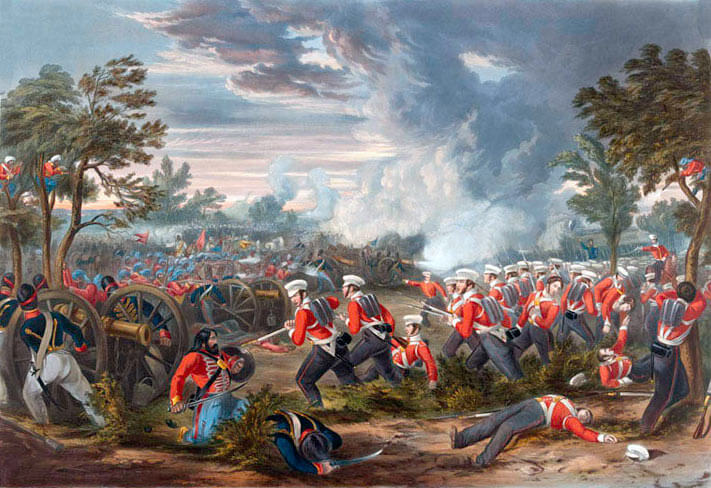
British infantry attack at the Battle of Moodkee on 18th December 1845 during the First Sikh War: picture by Henry Martens
In the centre, the infantry advanced to the attack; Smith’s division on the right; McCaskill’s division, only a brigade in strength, in the centre; and Gilbert’s, equally reduced in size with 45th BNI detached to guard the baggage, on the left. The British battalions, HM 9th, 31st and 50th Foot, led.
As the infantry advanced on the Sikh positions, Wheeler’s brigade on the right of the line, threatened by a mass of Sikh cavalry, formed squares. With the Sikhs driven off and the order to form line and continue the advance, only HM 50th complied, leaving the two BNI regiments of the brigade in square. The divisional commander, General Smith, seized one of the 50th’s colours and led the regiment into the Sikh lines.
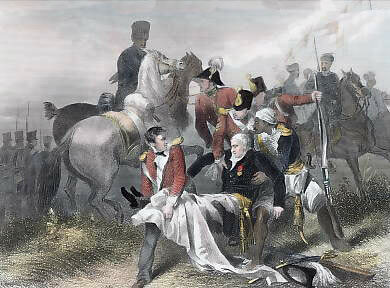
Mortal wounding of Major General Sir Robert Sale at the Battle of Moodkee on 18th December 1845 during the First Sikh War
The infantry attack drove the Sikhs from their positions after savage hand to hand fighting, in which two British generals, McCaskill and Sale, were killed.
In the gathering gloom, friendly units fired into each other, until finally complete darkness brought the battle to an end, the Sikhs withdrawing into the jungle.
Casualties at the Battle of Moodkee: Gough’s army of British and Bengal Native regiments suffered 872 killed and wounded in the battle. The predominant role played by four of the British regiments in the fighting is reflected in their casualties (414 in total):
HM 3rd King’s Own Light Dragoons suffered 61 killed and 35 wounded from a strength of 497, with 105 horses killed and 23 injured.
HM 9th Foot suffered 52 casualties.
HM 31st Foot suffered 157 casualties.
HM 50th Foot suffered 109 casualties.
42nd BNI suffered 89 casualties.
The British lost two generals killed: Sir John McCaskill and Sir Robert Sale (the commander at Jellalabad in the First Afghan War).
Sikh casualties are not known but may have been substantial. They lost 17 guns.
Follow-up to the Battle of Moodkee: Gough was criticised for the heavy casualties incurred in his headlong assault at the Battle of Moodkee. Hardinge took the view that Gough should have waited for the Sikhs to come out of the jungle and begin their attack, before launching a counter-attack. On the other hand, Gough feared that the Sikhs would not give battle once they had seen the strength of the Anglo-Indian army, but melt away into the jungle.
On the day after the battle, reinforcements arrived; HM 29th Regiment, 1st Bengal (European) Infantry, two Bengal Native Infantry regiments and two Howitzer guns.
On 20th December 1845, Gough moved on towards Ferozepore, where General Littler’s garrison waited to be relieved.
Anecdotes and traditions from the Battle of Moodkee:
- General Gough’s simple but expensive tactic of headlong attack was ruefully called by the army the ‘Tipperary Rush’.
- In action Gough wore his ‘Battle Coat’, a long white coat intended to draw enemy fire to him and away from his soldiers.
- Sergeant Jones of the 31st Foot rescued his regiment’s colours from the stricken ensigns and received an immediate battlefield commission.
- The Sikhs admired the conduct of the 3rd King’s Own Light Dragoons at Moodkee, giving them the nickname of the ‘Devil’s Children’; in Punjabi ‘Shaitan-ke-Bachche’. The Sikhs complained that the 3rd Light Dragoons came down on them ‘like a flash of lightning’. The regiment was given the nickname of the ‘Moodkeewallahs’ by the rest of the army, a label the regiment enthusiastically embraced.
- Captain Tritton of the 3rd King’s Own Light Dragoons captured a Sikh standard in the battle and Lance Sergeant Hinds with a party of troopers took two guns, after cutting down the gunners.
- Several light dragoons were killed after falling into the hands of the Sikhs. In later battles of the war the 3rd attacked with the cry ‘Remember Moodkee’ and gave no quarter. Throughout the Sikh Wars, it was not the practice of either side to give quarter.
- One of the Indian officers of the 47th Bengal Native Infantry captured a Sikh cannon during the battle.
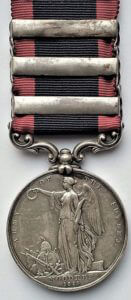
Sutlej Campaign, 1845-6 Medal recording the Battle of Moodkee on 18th December 1845 during the First Sikh War: reverse side
Medals and decorations from the Battle of Moodkee: British and Indian soldiers who took part in the First Sikh War received the medal entitled ‘Sutlej Campaign, 1845-6’.
Where a soldier took part in one or more battles, his medal would have the first battle inscribed on the reverse side of the medal, and the remaining battles on clasps on the ribbon.
The battles being described as: ‘Moodkee 1845’, ‘Ferozeshuhur 1845’, ‘Aliwal 1946’ and ‘Sobraon 1846’.
Description of the medal:
Obverse. -Crowned head of Queen Victoria. Legend: ‘Victoria Regina.’
Reverse. -Victory standing beside a trophy, holding a wreath in her outstretched hand. Inscription: ‘Army of the Sutlej.’
Mounting. -Silver scroll bar and swivel.
Ribbon: Dark blue with crimson edges. 1 ¼ inches wide.
References for the Battle of Moodkee:
History of the British Army by Fortescue.
History of British Cavalry by the Marquis of Angelsey.
The previous battle in the British Battle sequence is the Battle of Kabul 1842
The next battle in the First Sikh War is the Battle of Ferozeshah
